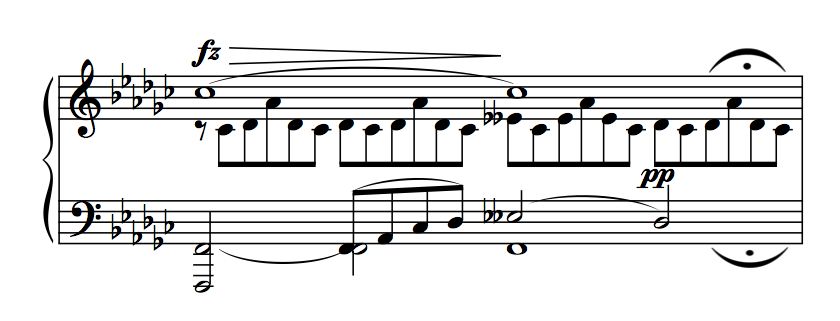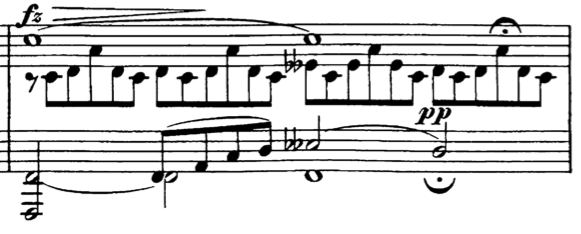Page 3 of 3
Re: Notational curiosity?
Posted: 17 Oct 2015, 16:28
by Knut
John,
your fermata looks fine to me, but considering Octo's point about symbol distinction I would perhaps make the tips a little thicker. I would leave the arc as is though. The conventional fermata shape is designed to be a lot shallower, and therefore looks good with a more circular arc. for a wider version like yours, the most natural arc would be more like a slur.
The placement is also fine. The top one is further from the notes than what one might expect, but it's nevertheless in good visual harmony with the bottom one and the high notes in the preceding measures.
In a plate engraved score it is not surprising that this kind of symbols would look a lot like a slur. There was no dedicated punches available for this, and the closest thing was a short slur punch or a compass for drawing longer slurs. Since modern engraving methods allow for more distinction, I see no reason to carry the original esthetics of the shape over in a modern context.
Re: Notational curiosity?
Posted: 17 Oct 2015, 16:44
by John Ruggero
Thanks, Knut and OCTO, I really appreciate your input. I will leave it as is, but thicken the tips.
OCTO, Neumann in "Ornamentation and Improvisation in Mozart" thinks that the Cosi excerpt should receive extensive ornamentation and gives an example (p. 220) that is VERY a piacere!
Re: Notational curiosity?
Posted: 19 Oct 2015, 11:54
by Vaughan
Your Mozart example is more "ritardando con ad lib. rubato e a piacere molto" ..

or, when accompanying singers: 'business as usual'!
Re: Notational curiosity?
Posted: 10 Jan 2016, 20:15
by John Ruggero
I recently came upon another of these special fermatas in the very famous Schubert Impromptu in Gb, op. 90. no. 3. The Wiener Urtext Edition (I assure the reader that I have no vested interest in the company) has the following authentic version, as reengraved by this poster:

- Fermatissimo.jpg (40.09 KiB) Viewed 9150 times
I wonder how many players have been confused by the notation shown here, from the Old Complete Works.

- Schubert Impromtu.Breitkopf.jpg (29.35 KiB) Viewed 9150 times
An older Henle edition at
http://conquest.imslp.info/files/imglnk ... -Henle.pdf has the same modernization, although there is a note indicated, probably to the critical report, that is unavailable on the file.
Re: Notational curiosity?
Posted: 10 Jan 2016, 21:59
by erelievonen
Not the same modernization. The Henle edition has placed the fermata on the last 8th note (which makes much more sense!), and they've added "(rit.)" in parentheses. These two taken together, in performance, may result in something very close to Schubert's intention. But I, too, think it'd be wiser not to modernize at all.
Re: Notational curiosity?
Posted: 10 Jan 2016, 23:23
by John Ruggero
Great catch, Ere. Yes, it's a different modernization, but I think it might be just as bad, because, in the wrong hands, it invites too long a hold and possibly emphasis of the final passing tone. The (rit.) does helps, but not perfectly.
The Breitkopf is so incomprehensible and impossible to do literally that it might cause a musician to just do what comes naturally with good results. I had played this piece from the Breitkopf and always assumed that since I was holding the the triplet tones through each other throughout the piece ("hand pedal"), the A flat and the following tones are also to be held through each other as if breaking a chord downward, and the fermata is, in that sense, intended for all three tones. Having now seen the correct notation, I would change nothing in the way I play this part.
Yes, I too think that this should not be modernized because Schubert has come up with the perfect notation. It confirms a possible interpretation that everyone suspects could happen here but just needs a little reassurance to implement. A fermata on any single note stands in the way of this confirmation. A rit. is also out of place, because the effect is not one of ritarding; it is a pulling back, as if taking a deep breath, without a sense of finality or loss of continuity.
The Wiener Urtext also adds a rit. in parenthesis, which I left out because of copyright concerns, but I think that it is redundant. If they were concerned about comprehension of the symbol, I don't think they needed to be.
Re: Notational curiosity?
Posted: 03 Oct 2019, 15:24
by John Ruggero
Another large fermata, this one combined with a quarter rest in the lower staff (Beethoven Piano Sonata op. 101):

- op 101 large fermata MS.jpeg (59.74 KiB) Viewed 5511 times
The first engraver got creative:

- op 101 large fermata 1st ed.jpeg (48.49 KiB) Viewed 5511 times
Later editions use a standard fermata under the rest, which seems sufficient. So why did Beethoven use this, to us, unusual notation? (Judging from some of the previous examples in this thread, it may not have been that unusual at the time.)
My take: Beethoven often fills up free measures with rests so they continue the pulse of the previous time signature. In this case, he thinks of the measure as being one measure of 2/4 (

=

of the preceeding 6/8) with a long hold on the second quarter as if it were a prolonged pickup, which it is. But since the second quarter is itself comprised of three long holds, it probably struck him as strange to see a quarter rest below equated to three half notes above and he comes up with a symbol to show the two levels of holding.
Re: Notational curiosity?
Posted: 04 Oct 2019, 07:09
by Schneider
Thank you for your explanation John, I'd never understood the manuscript measure by itself.
Re: Notational curiosity?
Posted: 04 Oct 2019, 19:21
by John Ruggero
You are very welcome, Schneider. But now the question is: do I engrave Beethoven's version, and if so, how?